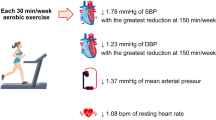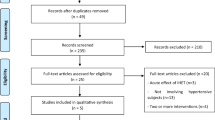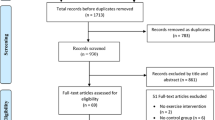Abstract
Exercise and relaxation decrease blood pressure. Qigong is a traditional Chinese exercise consisting of breathing and gentle movements. We conducted a randomised controlled trial to study the effect of Guolin qigong on blood pressure. In all, 88 patients with mild essential hypertension were recruited from the community and randomised to Goulin qigong or conventional exercise for 16 weeks. The main outcome measurements were blood pressure, health status (SF-36 scores), Beck Anxiety and Depression Inventory scores. In the qigong group, blood pressure decreased significantly from 146.3±7.8/93.0±4.1 mmHg at baseline to 135.5±10.0/87.1±7.7 mmHg at week 16. In the exercise group, blood pressure also decreased significantly from 140.9±10.9/93.1±3.5 mmHg to 129.7±11.1/86.0±7.0 mmHg. Heart rate, weight, BMI, waist circumference, total cholesterol, renin and 24 h urinary albumin excretion significantly decreased in both groups after 16 weeks. General health, bodily pain, social functioning and depression also improved in both groups. No significant differences between qigong and conventional exercise were found. In conclusion, Guolin qigong and conventional exercise have similar effects on blood pressure in patients with mild hypertension. While no additional benefits were identified, it is nevertheless an alternative to conventional exercise in the nondrug treatment of hypertension.
This is a preview of subscription content, access via your institution
Access options
Subscribe to this journal
Receive 12 digital issues and online access to articles
$119.00 per year
only $9.92 per issue
Buy this article
- Purchase on Springer Link
- Instant access to full article PDF
Prices may be subject to local taxes which are calculated during checkout


Similar content being viewed by others
References
Patel C, North WR . Randomised controlled trial of yoga and bio-feedback in management of hypertension. Lancet 1975; 2: 93–95.
Kokkinos PF et al. Effects of regular exercise on blood pressure and left ventricular hypertrophy in African-American men with severe hypertension. N Engl J Med 1995; 333: 1462–1467.
Chobanian AV et al. National Heart, Lung, and Blood Institute Joint National Committee on Prevention, Detection, Evaluation, and Treatment of High Blood Pressure; National High Blood Pressure Education Program Coordinating Committee. The seventh report of the Joint National Committee on Prevention, Detection, Evaluation, and Treatment of High Blood Pressure: the JNC 7 report. JAMA 2003; 289: 2560–2572.
World Health Organization. International Society of Hypertension Guidelines for the management of hypertension. J Hypertens 1999; 17: 151–183.
Sancier K . Medical applications of qigong. Altern Ther Health Med 1996; 2: 40–46.
Luskin FM et al. A review of mind–body therapies in the treatment of cardiovascular disease Part 1: implications for the elderly. Altern Ther Health Med 1998; 4: 46–61.
Ryu H et al. Effect of qigong training on proportions of T lymphocyte subsets in human peripheral blood. Am J Chin Med 1995; 23: 27–36.
Chen K, Yeung R . Exploratory studies of Qigong therapy for cancer in China. Integr Cancer Ther 2002; 1: 345–370.
Kuang A et al. Effect of qigong therapy on plasma 18-OH-DOC level in hypertensives. J Traditional Chin Med 1987; 7: 169–170.
Ryu H et al. Acute effect of qigong training on stress hormone levels in man. Am J Chin Med 1996; 24: 193–198.
Wang C, Xu D, Qian Y, Kuang A . [The beneficial effect of qigong on the ventricular function and microcirculation of deficiency of heart-energy hypertensive patients]. Chin J Modern Developments in Traditional Med 1991; 11: 659–660 (in Chinese).
Schein MH et al. Treating hypertension with a device that slows and regularises breathing: a randomised, double-blind controlled study. J Hum Hypertens 2001; 15: 271–278.
Grossman E et al. Breathing-control lowers blood pressure. J Hum Hypertens 2001; 15: 263–269.
Lim YA, Boone T, Flarity JR, Thompson WR . Effects of qigong on cardiorespiratory changes: a preliminary study. Am J Chin Med 1993; 21: 1–6.
Kuang A et al. Long-term observation on qigong in prevention of stroke—follow-up of 244 hypertensive patients for 18–22 years. J Traditional Chinese Med 1986; 6: 235–238.
Jones BM . Changes in cytokine production in healthy subjects practicing Guolin Qigong: a pilot study. BMC Complement Altern Med 2001; 1: 8.
Yu CM et al. Increase in plasma adrenomedullin in patients with heart failure characterised by diastolic dysfunction. Heart 2001; 86: 155–160.
Lam CL, Gandek B, Ren XS, Chan MS . Tests of scaling assumptions and construct validity of the Chinese (HK) version of the SF-36 Health Survey. J Clin Epidemiol 1998; 51: 1139–1147.
Ware JE, Snow KK, Kosinski M, Gandek B . SF-36 Health Survey Manual and Interpretation Guide. The Health Institute: Boston, MA, 1993.
Armitage P, Berry G . Statistical Methods in Medical Research, 3rd edn. Blackwell Scientific Publications: Oxford, 1994.
Diggle PJ, Liang KY, Zeger SL . Analysis of Longitudinal Data. Oxford University Press: Oxford, 1994.
Mayer M . Qigong and hypertension: a critique of research. J Altern Complement Med 1999; 5: 371–382.
Samaha FF et al. A low-carbohydrate as compared with a low-fat diet in severe obesity. N Engl J Med 2003; 348: 2074–2081.
Foster GD et al. A randomized trial of a low-carbohydrate diet for obesity. N Engl J Med 2003; 348: 2082–2090.
Wallace JP . Exercise in hypertension. A clinical review. Sports Med 2003; 33: 585–598.
Acknowledgements
The generous support from the Li Ka Shing Foundation is gratefully acknowledged. JCM Li was the Clinical Data Manager for the study. Ms SK Chan was the qigong instructor. Echocardiography was performed by Dr Q Wang. Numerous colleagues in the Clinical Trial Centre and Queen Mary Hospital have contributed to the study; their help is invaluable and is greatly appreciated. Permission to use the Chinese (HK) version of SF-36, and the Chinese version of the Beck Anxiety and Depression Inventory is gratefully acknowledged. ‘Beck Depression Inventory’, ‘BDI’, ‘Beck Anxiety Inventory’, and ‘BAI’ are registered trademarks of The Psychological Corporation, a Harcourt Assessment Company. All rights are reserved.
Author information
Authors and Affiliations
Corresponding author
Additional information
Conflict of interest: none. The study was funded by a charitable donation for research from the Li Ka Shing Foundation. The Foundation is not involved in the design, conduct, analysis and reporting of the study.
Rights and permissions
About this article
Cite this article
Cheung, B., Lo, J., Fong, D. et al. Randomised controlled trial of qigong in the treatment of mild essential hypertension. J Hum Hypertens 19, 697–704 (2005). https://doi.org/10.1038/sj.jhh.1001884
Received:
Revised:
Accepted:
Published:
Issue Date:
DOI: https://doi.org/10.1038/sj.jhh.1001884
Keywords
This article is cited by
-
Effect of leisure-time physical activity on blood pressure in people with hypertension: a systematic review and meta-analysis
Scientific Reports (2023)
-
Effects of qigong on systolic and diastolic blood pressure lowering: a systematic review with meta-analysis and trial sequential analysis
BMC Complementary Medicine and Therapies (2021)
-
Body Composition Outcomes of Tai Chi and Qigong Practice: A Systematic Review and Meta-Analysis of Randomized Controlled Trials
International Journal of Behavioral Medicine (2018)
-
RETRACTED ARTICLE: The efficacy of Guolin-Qigong on the body-mind health of Chinese women with breast cancer: a randomized controlled trial
Quality of Life Research (2017)
-
Effect of traditional Chinese exercise on the quality of life and depression for chronic diseases: a meta-analysis of randomised trials
Scientific Reports (2015)



